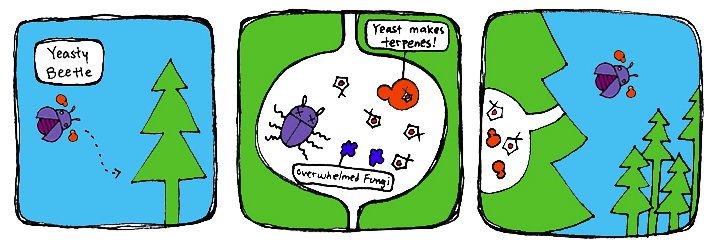Team:British Columbia/Model2
From 2011.igem.org
(→MODEL 2: Dynamics of Mountain Pine Beetle Populations in British Columbia) |
(→MODEL 2: Dynamics of Mountain Pine Beetle Populations in British Columbia) |
||
| Line 44: | Line 44: | ||
[[File:ubcigemmodel2comic.jpg | center ]] | [[File:ubcigemmodel2comic.jpg | center ]] | ||
| - | To restore the balance of monoterpenes to the trees, we propose to introduce our monoterpene producing yeast into the environment. Like the beetle's strategy, we will introduce our yeast products into trap boxes attracting the beetles by artificial pheromones. Just like the pine beetle infestation, the yeast will be carried through the pine beetle and into the tree. Previous studies in the literature have shown inhibition of blue-stain fungus growth upon interaction with certain concentrations of monoterpenes. Assuming that our product do inhibit the growth of blue-stain fungus due to the amount and certain monoterpenes produced, the introduction of our product will cause the same effect on the mountain pine beetle population, which depends on the blue-stain fungus. The | + | To restore the balance of monoterpenes to the trees, we propose to introduce our monoterpene producing yeast into the environment. Like the beetle's strategy, we will introduce our yeast products into trap boxes attracting the beetles by artificial pheromones. Just like the pine beetle infestation, the yeast will be carried through the pine beetle and into the tree. Previous studies in the literature have shown inhibition of blue-stain fungus growth upon interaction with certain concentrations of monoterpenes. Assuming that our product do inhibit the growth of blue-stain fungus due to the amount and certain monoterpenes produced, the introduction of our product will cause the same effect on the mountain pine beetle population, which depends on the blue-stain fungus. The larvae of the pine-beetle will be a much worse shape due to lack of food (the blue-stain fungus). And when they become adults, the availability of blue-stain fungi will be low. By keeping the population of blue-stain fungi in check, we will ultimately do the same for the pine beetle population. Theoretically speaking, the spread of our yeast product will be similar to the pine-beetle infestation and will peak out when pine-beetle population declines. |
| - | We understand that | + | We understand that this is a huge leap in connecting our lab work from the bench top to the environment, where no data exist on how well our product will have an impact on the pine beetle population in the wild. However, by creating this model, we |
Revision as of 03:03, 29 September 2011

MODEL 2: Dynamics of Mountain Pine Beetle Populations in British Columbia
Modeling the mountain pine beetle epidemic using a probabilistic clustering approach
The Beetle's Strategy
The mountain pine beetle lives in symbiosis with the blue-stain fungus (which has the ability to break down monoterpenes). Their relationship allows the mountain pine beetle to avoid the toxic effects of the monoterpenes, while the blue-stain fungi is carried inside the tree where it can happily grow and colonize. Monoterpenes produced by trees deter away insect attack, but stressed trees produce low amounts of monoterpenes. Due to this, both the pine beetle and the fungi exploit the tree for their own benefits. The beetles lay their larvaes inside, while the blue-stain fungi grows inside the tree and provide a source of nutrient for the young larvaes. Once the larvaes grow into adult beetles, they carry the blue-stain fungus and infects other trees. The trees die from this because the blue stain fungus blocks transport of water and nutrients. Like an infection, the pine beetle-blue stain fungi spreads throughout the forest, causing mass destruction to the forest health and ecosystems that rely on the trees.
Our Theoretical Strategy: iSynthase Trapbox
To restore the balance of monoterpenes to the trees, we propose to introduce our monoterpene producing yeast into the environment. Like the beetle's strategy, we will introduce our yeast products into trap boxes attracting the beetles by artificial pheromones. Just like the pine beetle infestation, the yeast will be carried through the pine beetle and into the tree. Previous studies in the literature have shown inhibition of blue-stain fungus growth upon interaction with certain concentrations of monoterpenes. Assuming that our product do inhibit the growth of blue-stain fungus due to the amount and certain monoterpenes produced, the introduction of our product will cause the same effect on the mountain pine beetle population, which depends on the blue-stain fungus. The larvae of the pine-beetle will be a much worse shape due to lack of food (the blue-stain fungus). And when they become adults, the availability of blue-stain fungi will be low. By keeping the population of blue-stain fungi in check, we will ultimately do the same for the pine beetle population. Theoretically speaking, the spread of our yeast product will be similar to the pine-beetle infestation and will peak out when pine-beetle population declines.
We understand that this is a huge leap in connecting our lab work from the bench top to the environment, where no data exist on how well our product will have an impact on the pine beetle population in the wild. However, by creating this model, we
Prediciton
We simulated the expansion of the MPB population from year 2011 to 2020 using the estimates obtained from the clustering analysis.
 "
"

